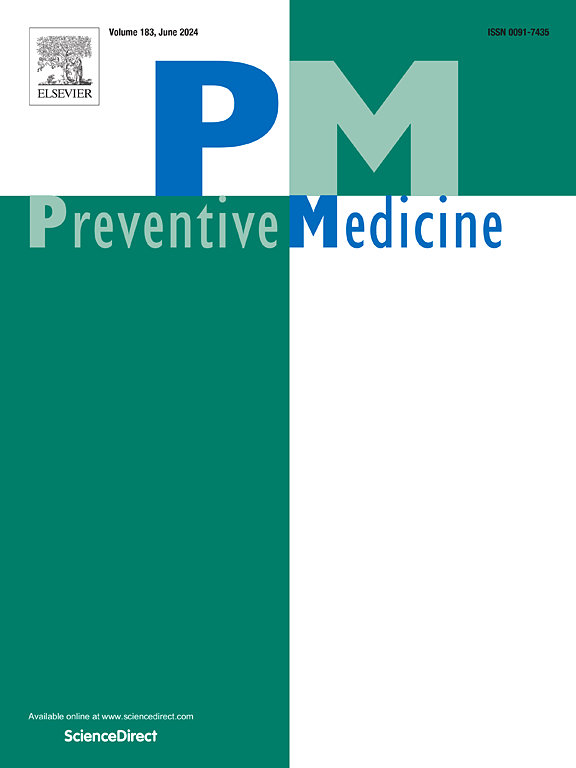Associations between state tobacco control measures and cigarette purchases by U.S. households, 2015–2021
IF 3.2
2区 医学
Q1 MEDICINE, GENERAL & INTERNAL
引用次数: 0
Abstract
Objective
While effects of key tobacco control policies are well-documented, limited research has explored their varying associations across different policy contexts over time. This is crucial given the diverse and evolving tobacco control contexts across states and over time. We evaluated the association between state-level tobacco control measures and cigarette purchases in the US from 2015 to 2021.
Methods
We analyzed NielsenIQ Consumer Panel data from 10,187 households that purchased cigarettes in 2015–2021. State-level tobacco control policy scores for smoke-free laws, taxes, prevention/control funding, and cessation services were obtained from the American Lung Association's State of Tobacco Control reports. Censored regression models, reporting adjusted beta estimates and 95 % confidence intervals (CI), estimated the associations between each tobacco control measure and annual household cigarette purchases, adjusting for sociodemographics (household composition, marital status, age, education, race/ethnicity, annual income, and internet connection) and accounting for clustering within households and states.
Results
Higher scores for smoke-free laws (adjusted beta = −1.00, 95 % CI = -1.73, −0.27), taxes (adjusted beta = −1.23, 95 % CI = -1.88, −0.58), and prevention/control funding (adjusted beta = −0.22, 95 % CI = -0.38, −0.06) were associated with fewer cigarette purchases over time. In the model considering all four measures together, higher tax score was associated with fewer cigarette purchases over time (adjusted beta = −0.96, 95 % CI = -1.73, −0.87).
Conclusions
Smoke-free laws, taxation, and prevention/control funding play critical roles in lowering cigarette purchases, while access to cessation services alone may not drive behavioral change. These findings highlight the need for comprehensive tobacco control efforts and renewed policy action to curb cigarette use.
2015-2021 年各州烟草控制措施与美国家庭卷烟购买量之间的关系
虽然主要烟草控制政策的影响有充分的文献记录,但有限的研究探索了它们在不同政策背景下随时间的不同关联。鉴于各州和各时期烟草控制环境的多样性和不断变化,这一点至关重要。我们评估了2015年至2021年美国州级烟草控制措施与卷烟购买之间的关系。方法:我们分析了2015-2021年购买香烟的10187个家庭的尼尔森iq消费者小组数据。从美国肺脏协会的烟草控制状况报告中获得了无烟法律、税收、预防/控制资金和戒烟服务方面的州一级烟草控制政策得分。审查回归模型报告了调整后的beta估计和95%置信区间(CI),估计了每项烟草控制措施与家庭年度卷烟购买之间的关联,调整了社会人口统计学因素(家庭构成、婚姻状况、年龄、教育程度、种族/民族、年收入和互联网连接),并考虑了家庭和州内的聚类。结果:随着时间的推移,无烟法律(调整后的贝塔系数= - 1.00,95% CI = -1.73, - 0.27)、税收(调整后的贝塔系数= - 1.23,95% CI = -1.88, - 0.58)和预防/控制资金(调整后的贝塔系数= - 0.22,95% CI = -0.38, - 0.06)的得分越高,香烟购买越少。在综合考虑所有四项措施的模型中,随着时间的推移,较高的税收得分与较少的香烟购买相关(调整后的贝塔系数= - 0.96,95% CI = -1.73, - 0.87)。无烟法律、税收和预防/控制资金在降低卷烟购买量方面发挥着关键作用,而仅获得戒烟服务可能无法推动行为改变。这些发现突出表明,有必要采取全面的烟草控制措施,并采取新的政策行动来遏制卷烟的使用。
本文章由计算机程序翻译,如有差异,请以英文原文为准。
求助全文
约1分钟内获得全文
求助全文
来源期刊

Preventive medicine
医学-公共卫生、环境卫生与职业卫生
CiteScore
7.70
自引率
3.90%
发文量
0
审稿时长
42 days
期刊介绍:
Founded in 1972 by Ernst Wynder, Preventive Medicine is an international scholarly journal that provides prompt publication of original articles on the science and practice of disease prevention, health promotion, and public health policymaking. Preventive Medicine aims to reward innovation. It will favor insightful observational studies, thoughtful explorations of health data, unsuspected new angles for existing hypotheses, robust randomized controlled trials, and impartial systematic reviews. Preventive Medicine''s ultimate goal is to publish research that will have an impact on the work of practitioners of disease prevention and health promotion, as well as of related disciplines.
 求助内容:
求助内容: 应助结果提醒方式:
应助结果提醒方式:


